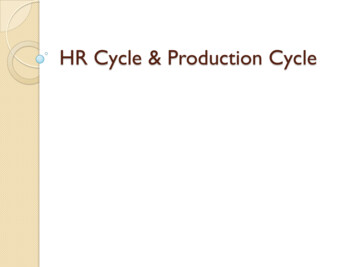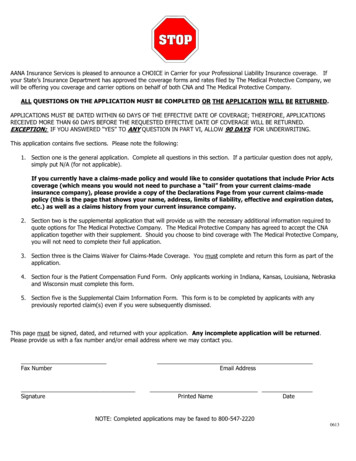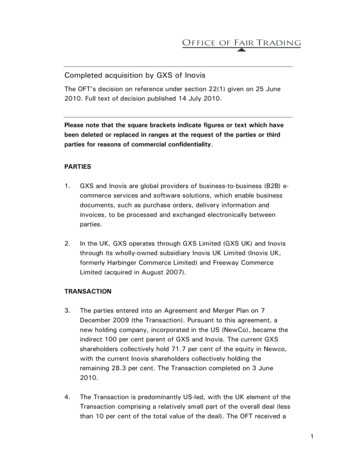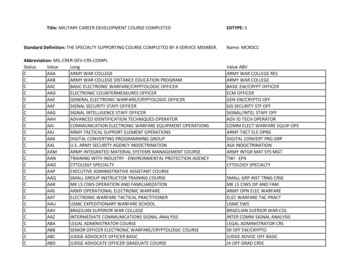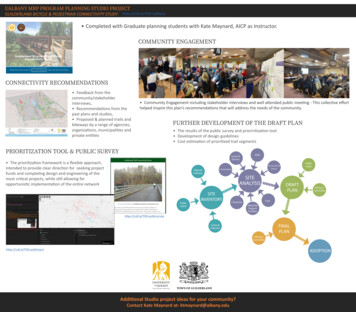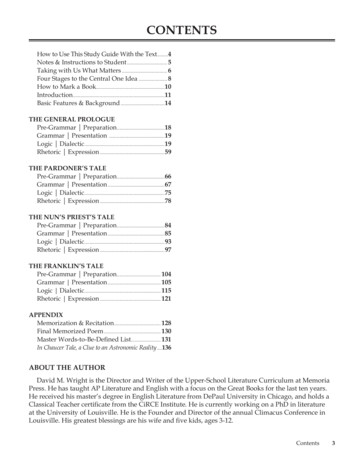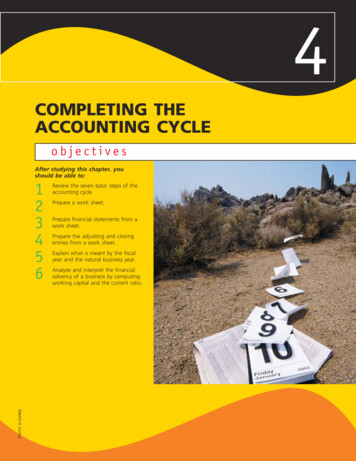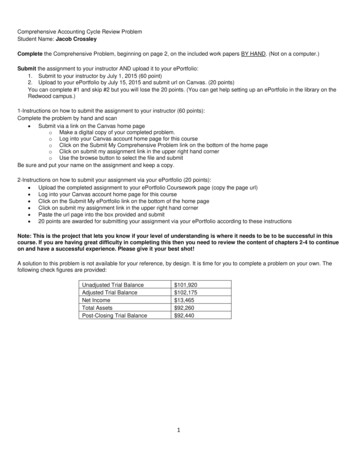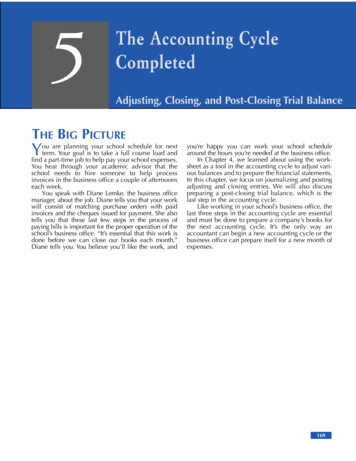
Transcription
5The Accounting CycleCompletedAdjusting, Closing, and Post-Closing Trial BalanceTHE BIG PICTUREYou are planning your school schedule for nextterm. Your goal is to take a full course load andfind a part-time job to help pay your school expenses.You hear through your academic advisor that theschool needs to hire someone to help processinvoices in the business office a couple of afternoonseach week.You speak with Diane Lemke, the business officemanager, about the job. Diane tells you that your workwill consist of matching purchase orders with paidinvoices and the cheques issued for payment. She alsotells you that these last few steps in the process ofpaying bills is important for the proper operation of theschool’s business office. “It’s essential that this work isdone before we can close our books each month,”Diane tells you. You believe you’ll like the work, andyou’re happy you can work your school schedulearound the hours you’re needed at the business office.In Chapter 4, we learned about using the worksheet as a tool in the accounting cycle to adjust various balances and to prepare the financial statements.In this chapter, we focus on journalizing and postingadjusting and closing entries. We will also discusspreparing a post-closing trial balance, which is thelast step in the accounting cycle.Like working in your school’s business office, thelast three steps in the accounting cycle are essentialand must be done to prepare a company’s books forthe next accounting cycle. It’s the only way anaccountant can begin a new accounting cycle or thebusiness office can prepare itself for a new month ofexpenses.169
ChapterObjectivesRemember: For ease ofpresentation, we are using amonth as the accountingcycle for Clark’s. In thebusiness world, the cycle canbe any time period but isusually one year. Journalizing and posting adjusting entries (p. 170) Journalizing and posting closing entries (p. 174) Preparing a post-closing trial balance (p. 184)In Chapters 3 and 4, we completed these steps of the manual accounting cycle forClark’s Desktop Publishing Services:Step 1:Step 2:Step 3:Step 4:Step 5:Step 6:Business transactions occurred and generated source documents.Business transactions were analyzed and recorded in a journal.Information was posted or transferred from journal to ledger.A trial balance was prepared.A worksheet was completed.Financial statements were prepared.This chapter covers the following steps, which will complete Clark’s accounting cycle for the month of May:Step 7: Journalizing and posting adjusting entriesStep 8: Journalizing and posting closing entriesStep 9: Preparing a post-closing trial balanceLearning Unit 5-1Journalizing and Posting Adjusting Entries: Step 7 of the Accounting CycleRECORDING JOURNAL ENTRIES FROM THE WORKSHEETPurpose of adjusting entriesAt this point, many ledgeraccounts are not up to date.170CHAPTER 5The information in the worksheet is up to date. The financial statements preparedfrom that information can give the business’s management and other interestedparties a good idea of where the business stands as of a particular date. The problem is that the worksheet is an informal report. The information concerning theadjustments has not been placed in the journal or posted to the ledger accounts.This means that the books are not up to date and ready for the next accountingcycle to begin. For example, the ledger shows 1,200 of prepaid rent (page 96), butthe balance sheet we prepared in Chapter 4 shows an 800 balance. Essentially, theworksheet is a tool for preparing financial statements. Now we must use the adjustment columns of the worksheet as a basis for bringing the ledger up to date. We dothis by adjusting journal entries (see Figure 5-1). Again, the updating must be donebefore the next accounting period starts. For Clark’s Desktop Publishing Services,the next period begins on June 1.Figure 5-1 shows the adjusting journal entries for Clark’s taken from theadjustments section of the worksheet (see Figure 5-2). Once the adjusting journalentries are posted to the ledger, the accounts making up the financial statementsthat were prepared from the worksheet will correspond with the updated ledger.(Keep in mind that this is the same journal we have been using.) Let’s look at somesimplified T accounts to show how Clark’s ledger looked before and after theadjustments were posted (see adjustments A to D on page 172).
Figure 5-1Adjusting Journal EntriesCLARK’S DESKTOP PUBLISHING SERVICESGENERAL JOURNALPage 2PRDr.5141145 0 0 0031 Rent ExpensePrepaid RentRent expired5151154 0 0 0031 Amortization Expense, DTP EquipmentAccumulated Amortization, DTP EquipmentEstimated amortization of asset5161228 0 0031 Office Salaries ExpenseSalaries PayableAccrued salary to May 315112123 5 0 00DateAccount Titles and DescriptionAdjusting EntriesMay 31 Office Supplies ExpenseOffice SuppliesOffice Supplies used upFigure 5-2Journalizing and PostingAdjustments from theAdjustments Section of theWorksheetAccount TitlesCashAccounts ReceivableOffice SuppliesPrepaid RentDesktop Publishing EquipmentAccounts PayableBrenda Clark, CapitalBrenda Clark, WithdrawalsDesktop Publishing FeesOffice Salaries ExpenseAdvertising ExpenseTelephone ExpenseOffice Supplies ExpenseRent ExpenseAmortization Expense,DTP EquipmentAccumulated Amortization,DTP EquipmentTrial BalanceDr.Cr.6150612Cr.5 0 0 004 0 0 008 0 003 5 0 00AdjustmentsDr.Cr.5 5 000 0 000 0 000 0 00(A) 5 0 0 00(B) 4 0 0 006 0 0 0 003 3 5 0 0010 0 0 0 006 2 5 008 0 0 0 00(D) 3 5 0 001 3 0 0 002 5 0 002 2 0 002 1 3 5 0 0021 3 5 0 00(A) 5 0 0 00(B) 4 0 0 00(C) 8 0 00(C)Salaries Payable8 0 00(D) 3 5 0 001 3 3 0 001 3 3 0 00THE ACCOUNTING CYCLE COMPLETED171
Adjustments A to D in theadjustments section of theworksheet must be recordedin the journal and posted tothe ledger.Adjustment ABefore posting:Office Supplies 114600Office Supplies Expense 514After posting:Office Supplies 114600 500Office Supplies Expense 514500Adjustment BBefore posting:Prepaid Rent 1151,200Rent Expense 515After posting:Prepaid Rent 1151,200 400Rent Expense 515400Adjustment CBefore posting:Desktop PublishingEquipment 1216,000AmortizationExpense, DTPEquipment 516AccumulatedAmortization,DTP Equipment 122AmortizationExpense, DTPEquipment 51680AccumulatedAmortization,DTP Equipment 12280After posting:Desktop PublishingEquipment 1216,000This last adjustment shows the same balances for Amortization Expense andAccumulated Amortization. However, in subsequent adjustments, the AccumulatedAmortization balance will keep getting larger, but the debit to AmortizationExpense and the credit to Accumulated Amortization will be the same. We will seewhy in a moment.Adjustment D172CHAPTER 5Before posting:Office SalariesExpense 511650650SalariesPayable 212After posting:Office SalariesExpense 511650650350SalariesPayable 212350
LEARNING UNIT 5-1 REVIEWAT THIS POINT you should be able to: Define and state the purpose of adjusting entries. (p. 170) Journalize adjusting entries from the worksheet. (p. 171) Post journalized adjusting entries to the ledger. (p. 171) Compare specific ledger accounts before and after posting of the journalizedadjusting entries. (p. 172)Self-Review Quiz 5-1(The blank forms you need are on pages X-X and X-X of the Study Guide withWorking Papers.)Turn to the worksheet of P. Logan Company (p. 140) and (1) journalize and postthe adjusting entries and (2) compare the adjusted ledger accounts before and afterthe adjustments are posted. T accounts with beginning balances are provided inyour Study Guide.Solution to Self-Review Quiz 5-1Quiz TipThese journal entries comefrom the adjustments columnof the worksheet.Page 2PRAccount Titles and DescriptionAdjusting EntriesDec. 31 Amortization Expense, Store Equipment511Accumulated Amortization, Store Equipment 122Estimated amortization of equipmentDateDr.Cr.1 001 0031 Insurance ExpensePrepaid InsuranceInsurance expired5161162 0031 Supplies ExpenseStore SuppliesStore Supplies used5141144 0031 Salaries ExpenseSalaries PayableAccrued salaries payable5122123 002 004 00THE ACCOUNTING CYCLE COMPLETED3 00173
PARTIAL LEDGERBefore PostingAfter tedExpense,Amortization,Expense,Amortization,Store Equipment 511Store Equipment 122Store Equipment 511Store Equipment 1224141Prepaid Insurance 1163Insurance Expense 516Prepaid Insurance 1163 2Insurance Expense 5162Store Supplies 1145Supplies Expense 514Store Supplies 1145 4Supplies Expense 5144Salaries Expense 5128Salaries Payable 212Salaries Expense 51283Salaries Payable 2123Learning Unit 5-2Journalizing and Posting Closing Entries: Step 8 of the Accounting CycleTo make recording of the next fiscal year’s transactions easier, a mechanical step,called closing, is taken by the accountant at Clark’s. Closing is used to end—orclose off—the revenue, expense, and withdrawal accounts at the end of the fiscalyear. The information needed to complete closing entries will be found in theincome statement and balance sheet sections of the worksheet.To make it easier to understand this process, we will first look at the differencebetween temporary (nominal) accounts and permanent (real) accounts.Here is the expanded accounting equation that we used in an earlier chapter:Assets Liabilities Capital – Withdrawals Revenues – ExpensesPermanent accounts arefound on the balance sheet.Three of the items in that equation—assets, liabilities, and capital—are knownas real or permanent accounts because their balances are carried over from onefiscal year to another. The other three items—withdrawals, revenue, andexpenses—are called nominal or temporary accounts because their balances arenot carried over from one fiscal year to another. Instead, their balances are set tozero at the beginning of each fiscal year. This allows us to accumulate new dataabout revenue, expenses, and withdrawals in the new fiscal year. The process ofclosing summarizes the effects of the temporary accounts on capital for that periodby using closing journal entries and by posting them to the ledger. When the closing process is complete, the accounting equation will be reduced to:Assets Liabilities Ending CapitalAfter all closing entries arejournalized and posted to theledger, all temporary accountshave a zero balance in theledger. Closing is a step-bystep process.174CHAPTER 5If you look back at page 142 in Chapter 4, you will see that we have calculatedthe new capital on the balance sheet for Clark’s Desktop Publishing Services to be 14,275. However, before the mechanical closing procedures are journalized andposted, the capital account of Brenda Clark in the ledger is only 10,000 (Chapter 3,page 96). Let’s look now at how to journalize and post closing entries.
HOW TO JOURNALIZE CLOSING ENTRIESAn Income Summary is atemporary account located inthe chart of accounts underOwner’s Equity. It does nothave a normal balance of adebit or a credit.There are four steps to be performed in journalizing closing entries:Step 1: Clear the revenue balances and transfer them to Income Summary.Income Summary is a temporary account in the ledger needed for closing.At the end of the closing process, there will be no balance in IncomeSummary.Revenue Income SummaryStep 2: Clear the individual expense balances and transfer them to IncomeSummary.Expenses Income SummarySometimes, closing theaccounts is referred to as“clearing the accounts.”Step 3: Clear the balance in Income Summary and transfer it to Capital.Income Summary CapitalStep 4: Clear the balance in Withdrawals and transfer it to Capital.Withdrawals CapitalDon’t forget two goals ofclosing:1. Clear all temporaryaccounts in the ledger.2. Update Capital to a newbalance that reflects asummary of all thetemporary accounts.All numbers used in theclosing process can be foundon the worksheet in Figure 54 (page 176). Note that theaccount Income Summary isnot on the worksheet.Figure 5-3Four Steps in JournalizingClosing EntriesFigure 5-3 is a visual representation of these four steps. Keep in mind that thisinformation must first be journalized and then posted to the appropriate ledgeraccounts. The worksheet presented in Figure 5-4 contains all the figures we willneed for the closing process.Step 1: Clear Revenue Balances and Transfer to Income SummaryHere is what is in the ledger before closing entries are journalized and posted:Desktop Publishing Fees 4118,000Income Summary 313The income statement section on the worksheet on page 176 shows that theDesktop Publishing Fees account has a credit balance of 8,000. To close or clearthis to zero in the ledger, a debit of 8,000 is needed. However, if we add anamount to the debit side, we must also add a credit—so we add 8,000 on thecredit side of the Income Summary account.Step 1:RevenueStep 2:ExpensesStep 3:INCOME SUMMARYNet Income or Net LossStep 4:WithdrawalsCapitalTHE ACCOUNTING CYCLE COMPLETED175
Figure 5-4Closing Figures on theWorksheetIncome StatementDr.Cr.Account TitlesCashAccounts ReceivableOffice SuppliesPrepaid RentDesktop Publishing EquipmentAccounts PayableBrenda Clark, CapitalBrenda Clark, WithdrawalsDesktop Publishing FeesOffice Salaries ExpenseAdvertising ExpenseTelephone ExpenseOffice Supplies ExpenseRent ExpenseAmortization Exp., DTP Equip.Accum. Amort., DTP Equip.Salaries PayableNet IncomeBalance SheetDr.Cr.6 1 5 5 005 0 0 0 001 0 0 008 0 0 006 0 0 0 003 3 5 0 0010 0 0 0 00For Step 1For Step 26 2 5 008 0 0 0 00For Step 41 6 5 0 002 5 0 002 2 0 005 0 0 004 0 0 008 0 00For Step 33 1 0 0 008 0 0 0 0018 6 8 0 008 0 003 5 0 0013 7 8 0 004 9 0 0 008 0 0 0 008 0 0 0 0018 6 8 0 004 9 0 0 0018 6 8 0 00The following is the journalized closing entry for step 1:May 31 Desktop Publishing FeesIncome SummaryTo close income account4113138 0 0 0 008 0 0 0 00This is what Desktop Publishing Fees and Income Summary should look likein the ledger after step 1 closing entries are journalized and posted:Desktop Publishing Fees 4118,000 8,000
In Chapters 3 and 4, we completed these steps of the manual accounting cycle for Clark’s Desktop Publishing Services: Step 1: Business transactions occurred and generated source documents. Step 2: Business transactions were analyzed and recorded in a journal. Step 3: Information was posted or transferred from journal to ledger.File Size: 756KBPage Count: 65


